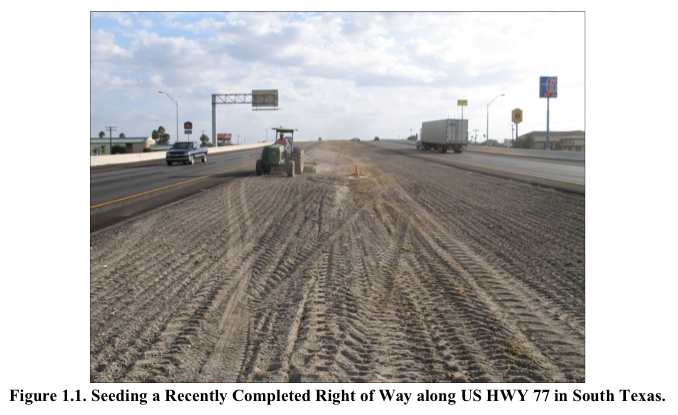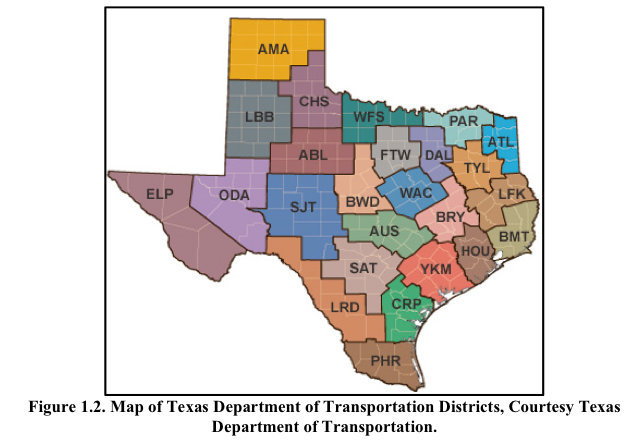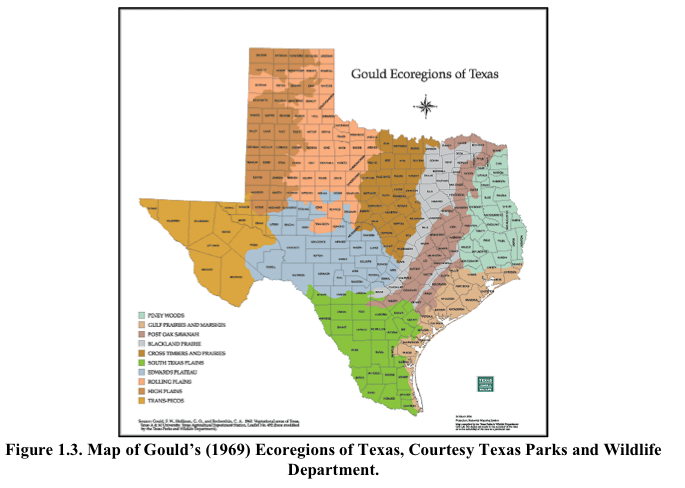CAESAR KLEBERG WILDLIFE RESEARCH INSTITUTE
Introduction
Restoring vegetative cover on disturbed or engineered soils following roadway construction is a minor part of the overall workload of the Texas Department of Transportation (TxDOT). But the resultant plant communities that exist along Texas’ 80,000 miles of roadways may well be the most visible and cared about portion of a roadway to many members of the public, natural resource managers, and especially adjacent landowners. Historic (TxDOT 1995) and recent (TxDOT 2004) use of exotic grasses for erosion control is a major complaint against the agency. While little empirical evidence has been gathered to support it, the near-consensus conclusion among the general public and natural resource managers is that TxDOT use of exotic grasses such King Ranch bluestem (Bothriochloa ischaemum L. Keng) and Bermudagrass (Cynodon dactylon (L.) Pers.) along roadways is the primary reason for their current prevalence in the state of Texas. Other common exotic grasses on Texas roadsides, such as Kleberg bluestem (Dichanthium annulatum (Forssk.) Stapf.), Johnsongrass (Sorghum halepense (L.) Pers.), Wilman lovegrass (Eragrostis superba Peyr.), and guineagrass (Urochloa maxima (Jacq.) R. Webster) have not been specified for use, or planted by the agency, yet do exist on and spread from TxDOT rights of way.
In south Texas (Laredo, San Antonio, Corpus Christi, and Pharr TxDOT Districts), TxDOT (2004) (Figure 1.1) seed mixture specifications include both native and exotic grass seed in order to establish permanent vegetation for erosion control on highway rights of way. Exotic species include Bermudagrass, buffelgrass (Pennisetum ciliare (L.) Link), and Lehmann lovegrass (Eragrostis lehmanniana Nees). Ecotypic seeds of native plant species specified for south Texas districts were not available commercially before this project. Substantial evidence suggests native seeds used for restoration and reclamation should originate from populations from the same ecosystem as the planting site in order for best performance (Johnson et al. 2010). TxDOT districts in south Texas fall primarily within the Gulf Prairies and Marshes and South Texas Plains ecoregions of Texas (Gould 1969) (Figure 1.2).
Native species included in current TxDOT specifications for south Texas include the grasses green sprangletop (Leptochloa dubia (Kunth) Nees), sideoats grama (Bouteloua curtipendula (Michx.) Torr.), plains bristlegrass (Setaria vulpiseta (Lam.) Roem. & Schult.), buffalograss (Bouteloua dactyloides (Nutt.) J.T. Columbus), sand dropseed (Sporobolus cryptandrus (Torr.) A. Gray), little bluestem (Schizachyrium scoparium (Michx.) Nash), sand lovegrass (Eragrostis trichodes (Nutt.) Alph. Wood); and forbs Illinois bundleflower (Desmanthus illinoensis (Michx.) MacMill. Ex B.L. Rob. & Fernald), purple prairie clover (Dalea purpurea Vent.), and partridge pea (Chamaecrista fasciculata (Michx.) Greene).
Of the currently available commercial varieties of these native species that meet TxDOT (2004) and Texas Seed Law (TDA 1988) specifications allowing use in roadside plantings, only one species (Sabine Illinois bundleflower-Gulf Prairies and Marshes) originates from a south Texas ecoregion (Table 1.1). One additional species, Mason sand lovegrass, narrowly falls within the accepted ecotypic range of the far northern portion of the San Antonio District only.
Because of the poor performance of seed of these maladapted or non-ecotypic native seed mixture components, TxDOT continues to include exotic grass seed (i.e., buffelgrass, Lehman lovegrass, and Bermudagrass) in seeding mixes and specification to meet Federal vegetation cover mandates of the Clean Water Act (USEPA 2010). However, compliance with these Clean Water Act Provisions is in direct violation of the more recent Executive Order 13112 on Invasive Species (Clinton 1999), which directs government agencies to provide for the restoration of 3 native species along roadsides, and not authorize, fund, or carry out actions that are likely to cause or promote the introduction or spread of invasive species.
In order to make ecotypic sources of native seeds available for south Texas and meet both coverage and native species use requirements, Project 0-4570 South Texas Native Plant Restoration Project, was initiated in 2001. Goals of the project included collection of local seed ecotypes of native plants, evaluating and selecting collections of potential use by TxDOT, facilitating their production by local commercial seed growers, and finally ensuring ecotypic native seeds are available to end users such as TxDOT for reseeding projects in south Texas (Markwardt 2005).
Read full report (PDF) here: South Texas Native Plant Restoration Project
About The Caesar Kleberg Wildlife Research Institute at Texas A&M University-Kingsville
www.ckwri.tamuk.edu
“The Caesar Kleberg Wildlife Research Institute at Texas A&M University-Kingsville is the leading wildlife research organization in Texas and one of the finest in the nation. Its mission is to provide science-based information for enhancing the conservation and management of wildlife in South Texas and related environments.”
Tags: Cesar Kleberg Wildlife Research Institute, South Texas, Texas, Texas Department of Transportation, TX, TxDOT, US Highway 77







 RSS Feed
RSS Feed